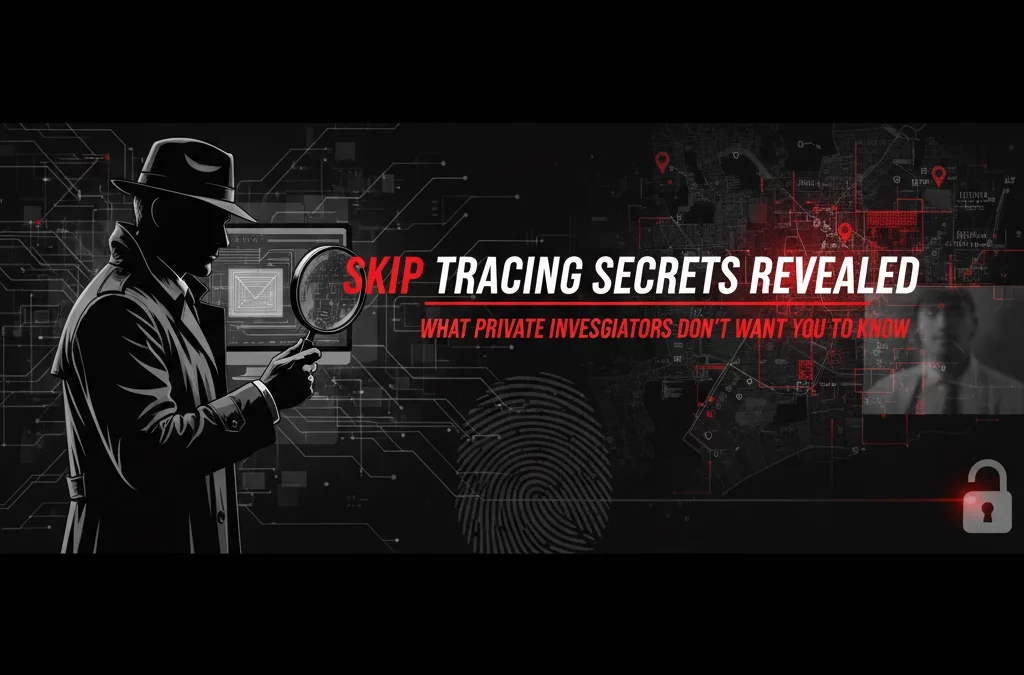You’ve probably heard the term “skip tracing” thrown around, maybe in a movie or during a conversation about debt collection. But what exactly goes on behind the scenes when a private investigator is hunting down someone who’s gone off the grid?
Here’s the thing – most of what we do isn’t nearly as mysterious as you might think. In fact, many of the techniques we use are available to anyone willing to put in the time and effort. The real “secret” isn’t the tools themselves, but knowing how to use them effectively and legally.
What Skip Tracing Really Means
Skip tracing is basically the art and science of finding people who don’t want to be found. The term “skip” comes from the old phrase “to skip town” – when someone disappears to avoid debts, legal troubles, or other responsibilities. As a private investigator, I’ve tracked down everyone from runaway teenagers to deadbeat parents, missing witnesses, and people who’ve simply vanished without a trace.
The reality is that in today’s digital world, it’s incredibly difficult to completely disappear. Most people leave digital breadcrumbs everywhere they go, and professional investigators know exactly where to look for these clues.

The Database Deep Dive
One of the first things we do is hit the databases – and there are way more of them than you might realize. We’re talking about public records that include everything from voter registrations to property deeds, court filings to business licenses. These records paint a picture of someone’s life that most people don’t even realize exists.
Credit reports are goldmines of information. They don’t just show someone’s credit score – they reveal address histories, employment records, and even utility connections. When someone moves and thinks they’ve covered their tracks, their credit report often tells a different story.
But here’s where it gets interesting. We also use specialized databases that aggregate information from hundreds of sources. These might include magazine subscriptions, warranty registrations, loyalty card applications, and even social media check-ins. You’d be surprised how much information people voluntarily give away without thinking twice about it.
Social Media: The Modern Paper Trail
Let’s be honest – social media has made our job both easier and more complicated. Easier because people share everything online, but more complicated because there’s so much noise to filter through.
The trick isn’t just looking at the target’s social media accounts. We examine their entire network. Friends, family members, co-workers, even that person who liked their photo from three years ago. People may be careful about their own posting habits, but they can’t control what others share about them.
We look for location tags, background details in photos, and even the metadata embedded in images. That innocent selfie someone posted might contain GPS coordinates that pinpoint exactly where they were when they took it.

Phone and Utility Forensics
Here’s something most people don’t consider – your phone and utility bills create a detailed map of your movements. Every time you connect to a cell tower, use a credit card, or pay a utility bill, you’re essentially checking in with various databases.
We can trace phone numbers through carrier records, look up utility connections at different addresses, and even track vehicle registrations. These records often update more frequently than traditional address databases, giving us real-time insights into someone’s current location.
But there’s a legal limit to what we can access. We can’t tap phones or access private call records without proper authorization. What we can do is use publicly available information to build a comprehensive picture of someone’s movements and habits.
The Art of Human Intelligence
Technology only gets you so far. Sometimes the best information comes from good old-fashioned conversation. We contact neighbors, former co-workers, landlords, and anyone else who might have crossed paths with our target.
The key is knowing how to ask questions without raising red flags. We might pose as someone conducting a survey, following up on a delivery, or checking references for employment. It’s all about building rapport and asking the right questions in the right way.
Family members and close friends are usually protective, but casual acquaintances often share information without realizing its significance. That neighbor who mentions seeing someone loading a moving truck, or the former co-worker who heard someone talking about relocating to another state – these conversations can provide crucial leads.

What We Actually Can’t Do
Now here’s where I need to set the record straight. Despite what you see in movies, there are strict legal and ethical boundaries that legitimate private investigators must follow.
We can’t access bank records without proper legal authority. We can’t tap phones, install tracking devices on vehicles we don’t own, or hack into private email accounts. We can’t impersonate law enforcement officers or use illegal surveillance techniques.
What we can do is work within the legal framework to gather publicly available information and use it strategically. The “secret” isn’t having access to classified databases – it’s knowing how to connect the dots between different pieces of information that are already out there.
We also can’t find real-time GPS locations or live-track someone’s movements without their consent or a court order. If a PI claims they can do these things, you should be very suspicious of their methods and legality.
The Verification Process
One thing that separates professional investigators from amateur skip tracers is the verification process. Anyone can find information online, but not everyone knows how to verify its accuracy.
We cross-reference information from multiple sources, check dates for consistency, and verify details through independent channels. False leads and outdated information can waste enormous amounts of time and resources, so this verification step is crucial.
We also understand how to distinguish between someone who’s actively hiding and someone who’s simply moved on with their life. The techniques and approach vary significantly depending on the subject’s intentions and circumstances.

Why People Hire Us Instead of Doing It Themselves
You might be wondering – if these techniques aren’t really “secret,” why don’t people just do their own skip tracing? The answer comes down to time, expertise, and legal knowledge.
Professional skip tracing requires understanding which databases to search, how to interpret the information you find, and most importantly, how to stay within legal boundaries. It’s not just about finding someone – it’s about finding them in a way that won’t land you in legal trouble.
We also have access to professional-grade databases that aren’t available to the general public. These databases are expensive and require proper licensing and training to use effectively.
The Bottom Line
The biggest “secret” in skip tracing isn’t really a secret at all – it’s simply the systematic application of research skills, database knowledge, and investigative experience. Most of the information we use is publicly available if you know where to look and how to interpret it.
What you’re really paying for when you hire a professional investigator is expertise, efficiency, and peace of mind. We know which leads to pursue and which ones are dead ends. We understand how to gather information legally and ethically, and we have the experience to know when to keep pushing and when to try a different approach.
If you’re dealing with a situation that requires locating someone who doesn’t want to be found, remember that professional help often saves time, money, and potential legal complications. At Facts Investigations, we bring years of experience and professional resources to every case, ensuring that your skip tracing needs are handled efficiently and within legal boundaries.
The real secret? Sometimes the best approach is simply knowing when to call in the professionals who do this work every day.

